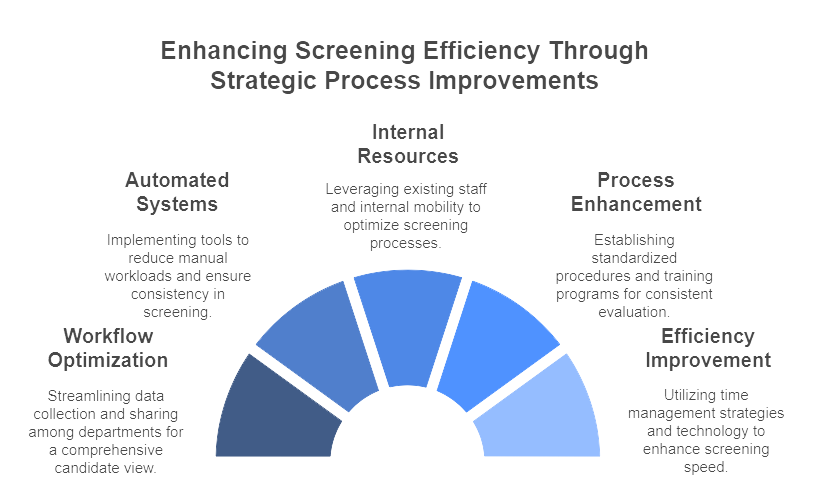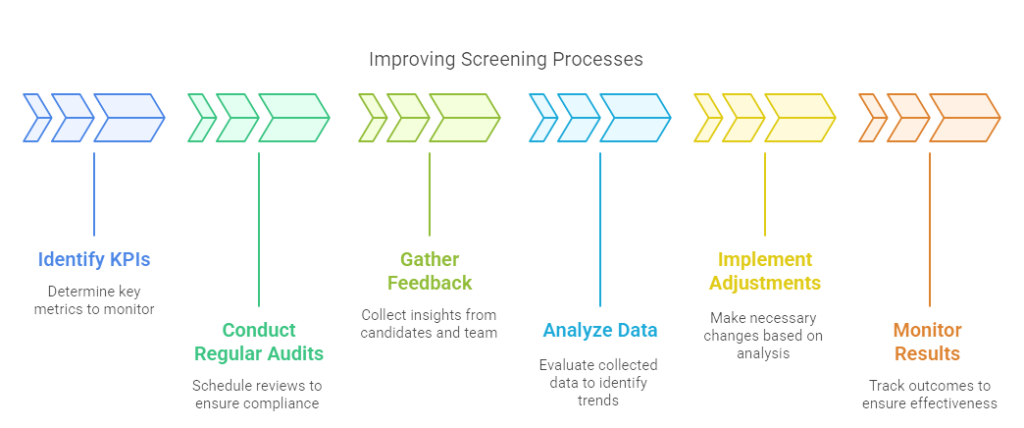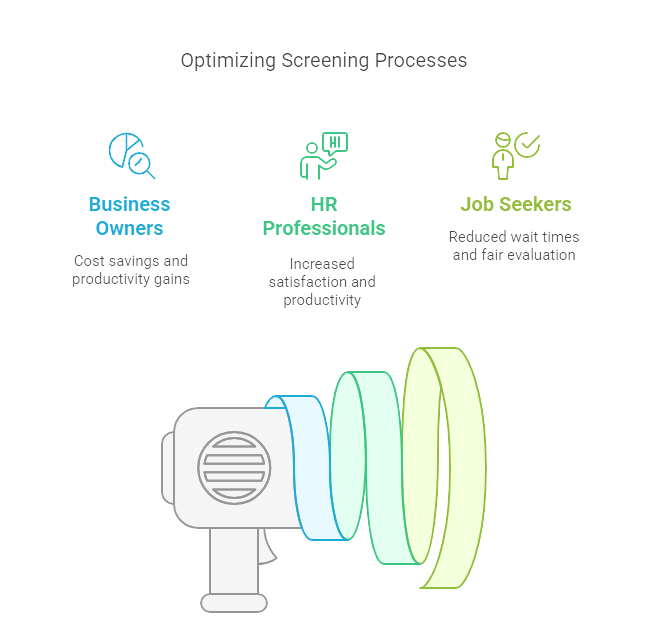In today's competitive job market, ensuring that you have the best possible candidates is more critical than ever. But how can business owners, HR professionals, recruiters, and job seekers navigate the complexities of hiring efficiently? The answer lies in process improvement in screening. In this guide, we'll explore various strategies to optimize workflows, enhance procedures, and ultimately improve efficiency in the screening process.
Key Takeaways
- Optimizing the screening process reduces inefficiencies, increasing both the quality of hires and organizational performance.
- Key strategies for improvement include data integration, automated systems, and internal resource utilization.
- Standardized procedures, ongoing training programs, and robust feedback loops are essential for process enhancement.
- Tracking KPIs, regular audits, and fostering continuous feedback ensure the effectiveness of the improved screening processes.
- Real-world applications show that improved screening benefits business owners, HR professionals, recruiters, and job seekers alike.
Introduction
Ever found yourself exhausted by the tedious and time-consuming process of sifting through stacks of resumes and never-ending interviews, only to end up with a subpar candidate? You're not alone. Inefficiencies in the screening process are a common frustration in the hiring landscape, resulting in wasted time, missed opportunities, and high turnover rates. This article aims to address these pain points by outlining actionable steps to improve the screening process, making it leaner and more effective.
Process improvement in screening involves re-evaluating and refining various stages of your current hiring procedures. It's about identifying bottlenecks, implementing technological solutions, and creating standardized protocols to ensure a more streamlined approach. Why is this essential? An optimized screening process not only saves time and resources but also elevates the quality of hires, ultimately boosting organizational performance.
In the sections that follow, we'll delve into key strategies for workflow optimization, process enhancement, and efficiency improvement. By the end of this guide, you'll have a comprehensive understanding of how to overhaul your screening process, making it faster, fairer, and more effective. Whether you're a business owner, HR professional, recruiter, or job seeker, these insights will help you navigate the complexities of hiring with greater ease and confidence.

Understanding the Current Screening Process
Existing Challenges
Let’s face it: the present-day screening process is fraught with inefficiencies. Recruiters often face bottlenecks, such as stacks of resumes that are barely scanned, time-consuming reference checks, and inconsistent interview protocols. These inefficiencies lead to missed opportunities and, worse, subpar hires. It's not uncommon for hiring managers to overlook qualified candidates simply because the current screening methods are too slow and cumbersome.
Initial Assessment
Periodically reviewing your screening procedures is not just a good practice; it's a necessity. An initial assessment allows you to identify and address weak points in your current process. Are you leveraging outdated methods? Is there redundancy in steps? These questions can guide your review. Remember, regular assessments ensure that your screening process remains effective and adaptable to new hiring challenges and opportunities.
Real-World Impact
The real-world implications of an inefficient screening process can be significant. Based on studies, companies with poor screening protocols report up to 39% higher turnover rates, costing them thousands in recruitment and training expenses. For instance, a business that fails to promptly identify quality candidates due to a sluggish process might end up with a less effective team and lower overall productivity. Moreover, the prolonged hiring timeline can result in critical roles remaining vacant, thereby slowing down key projects and operational efficiency.
Streamlining your screening process isn’t just about saving time; it’s about enhancing the quality of your hires, reducing turnover, and ultimately driving better business outcomes. So, before we jump into the strategies for process improvement, it's crucial to understand where the current system stands and why change is necessary.
EXPERT INSIGHT: Hiring is more than finding the right people—it’s creating the right process to find them. I discovered that an unproductive, out-of-sync screening process loses more than time—it loses trust, talent, and long-term success. When we began to invest in automation, standardization, and continuous feedback, things shifted—not only our hiring tempo, but the quality of candidates we drew to us. Making the process lean was more than tactical—it was revolutionary. Because when screening respects people’s time, talent, and potential, the right people arrive and stay. - Charm Paz, CHRP
Key Strategies for Process Improvement in Screening
Workflow Optimization
Data Integration
In today's data-driven world, the first step to optimizing the screening process is streamlining data collection and sharing among departments. Unifying data sources through integrated systems provides a comprehensive view of candidates, reducing discrepancies and manual errors. Think of it as creating a single, synchronized database accessible by all relevant teams, from HR to department heads to administrative staff.
Automated Systems
Automation is a game-changer when it comes to reducing manual workloads. Implementing automated screening tools can significantly cut down on time spent reviewing resumes, conducting background checks, and even initial applicant communication. Automated systems not only speed up the process but also ensure higher consistency and accuracy, which is crucial for fair candidate evaluation.
Utilize Internal Resources
Leveraging existing internal resources can be another effective way to optimize your screening process. Often, training your current staff to better handle screening tasks, or utilizing internal mobility for open positions, can prove more efficient than hiring externally. Utilizing a well-structured employee referral program can also streamline finding the right talent quickly and efficiently.
Process Enhancement
Standardized Procedures
Establishing standardized screening protocols ensures consistency across the board. From resume screening to behavioral interviews, having a standardized procedure means every candidate is assessed based on the same criteria. This not only improves fairness but also enhances the comparability of applications.
Training Programs
Regular training programs for HR staff are pivotal. Staying updated with the latest trends, tools, and best practices in screening ensures that your team is performing at its most effectively. Continuous education helps in honing the skills needed to spot the perfect candidate from a sea of submissions.
Feedback Loops
The backbone of any process improvement lies in continuous feedback. Engaging with stakeholders—candidates, hiring managers, and HR counterparts—for feedback will provide valuable insights into areas of improvement. A robust feedback loop helps in ironing out the kinks and setting the stage for constant refinement of the screening process.
Efficiency Improvement
Time Management
Time is of the essence in screening. Developing time management strategies, such as setting predefined timelines for each stage of the screening process, can greatly enhance efficiency. Using tools like scheduling software for interviews and follow-ups ensures that no time is wasted, and every stakeholder is on the same page.
Clear Criteria
Establishing clear benchmarks for evaluating candidates can drastically reduce the time spent on decision-making. When everyone knows what qualities and qualifications are non-negotiable, it becomes easier to filter out unsuitable candidates early in the process, saving time and effort.
Technology Utilization
Leveraging the latest technological advancements is another key strategy. Technologies such as Artificial Intelligence (AI) and Machine Learning (ML) can assist in predictive hiring, where algorithms provide recommendations based on historical data. These technologies not only speed up the screening process but also enhance accuracy, giving you a competitive edge in securing top talent.
By embracing these key strategies, you'll find that screening becomes not only more efficient but also more effective, ultimately leading to better hires and a stronger workforce.

Implementing Workflow Optimization
Step-by-Step Guide
- Map Your Current Workflow: Visualize every step of your existing screening process, from sourcing candidates to final evaluation. Use flowcharts or diagrams to see where redundancies and bottlenecks occur.
- Define Objectives: Identify what you aim to achieve through optimization. This could include reducing time-to-hire, minimizing manual errors, or improving the candidate experience.
- Integrate Data Systems: Ensure all data collection points—applications, initial screens, interviews—are interconnected. Use integrated software solutions to keep data flowing seamlessly between departments.
- Automate Routine Tasks: Deploy automated tools for tasks like resume screening, scheduling interviews, and sending follow-up emails. Automating repetitive functions can significantly reduce workload and processing times.
- Leverage Internal Resources: Utilize existing tools and systems more effectively. For instance, if you already have an Applicant Tracking System (ATS), explore its full suite of features to enhance workflow coordination.
- Standardize Procedures: Develop and implement standardized screening protocols. Consistency not only streamlines processes but also ensures every candidate is evaluated against the same criteria.
Monitoring Tools
- Project Management Software: Tools like Trello, Asana, or Monday.com can help you track the stages of the screening process and assign tasks to team members.
- Analytics Platforms: Use platforms like Google Analytics, Tableau, or your ATS's built-in analytics to monitor key metrics such as time-to-hire, candidate drop-off rates, and screening accuracy.
- Feedback Mechanisms: Set up automated feedback forms to gather insights from candidates and staff. Tools like SurveyMonkey or Google Forms can help you analyze the data quickly.
Case Studies
- Company A: Streamlining with Automation: By introducing an AI-powered resume screening tool, Company A cut their initial screening time by 70%. This allowed recruiters to focus more on candidate engagement rather than sifting through piles of resumes.
- Company B: Integrating Data Systems: After implementing integrated data solutions, Company B saw a 50% reduction in data entry errors and a 30% improvement in applicant tracking. This led to a more transparent and efficient hiring process.
- Company C: Standardizing Screening Protocols: By developing standardized interview questions and evaluation criteria, Company C improved the consistency and fairness of its screening process, resulting in a 25% increase in hire quality metrics.
Effective workflow optimization is not just about cutting steps; it’s about making every step count. By mapping out your current processes, defining clear objectives, automating routine tasks, leveraging internal resources, and standardizing procedures, you'll find that your screening process not only becomes faster and more efficient but also far more reliable.
Enhancing the Screening Process
Enhancing the screening process starts with developing clear, coherent policies that align with your organizational goals. These policies should be thorough yet flexible to adapt to evolving needs. A robust screening policy encompasses everything from the criteria for evaluating candidates to the methods of data collection and analysis. This level of clarity not only streamlines the process but also ensures consistency and fairness.
Compliance is non-negotiable when refining your screening process. Your methods must adhere to applicable legal and regulatory frameworks to avoid costly penalties and potential lawsuits. For example, you need to follow guidelines set forth by regulatory bodies like the Department of Labor and the Society for Human Resource Management (SHRM). These guidelines offer extensive resources and toolkits to help you navigate the legal landscape.
Quality control measures also play a vital role in process enhancement. Implementing quality checks at different stages of the screening process ensures the maintenance of improved standards. These measures can include routine audits, peer reviews, and automated systems designed to catch inconsistencies or errors. The goal is to create a seamless experience that filters out unqualified candidates while highlighting top talent effectively.
By focusing on policy development, compliance, and quality control, you can significantly enhance the screening process. These improvements not only foster a more efficient and consistent hiring procedure but also build a foundation of trust and reliability within your organization.
Measuring the Impact of Efficiency Improved Screening Processes
Efficiency without measurement is a shot in the dark. To ensure your improved screening processes deliver the results you seek, it's essential to keep track of specific Key Performance Indicators (KPIs), conduct regular audits, and foster a feedback-forward environment.
Key Performance Indicators (KPIs)
To truly understand if your process improvements are hitting the mark, you'll need to monitor a few crucial KPIs:
- Time-to-Hire: Measures the total days from job posting to candidate acceptance. An optimized process should see a reduction in this metric.
- Cost-Per-Hire: Calculates the total cost involved in hiring, including advertising, recruiter fees, and the time of employees involved in the process. An efficient process often brings this number down.
- Candidate Quality: Gauge the performance of new hires based on their initial reviews, tenure, and productivity to see if your screening is catching the right talent.
- Offer Acceptance Rate: Track the percentage of job offers accepted by candidates. A higher rate can indicate not only efficient screening but also an attractive hiring process.
Regular Audits
Audits are your inspection checkpoints. Regular audits help to ensure that the improvements you've made are being followed and stay effective over time. Here's how to go about it:
- Scheduled Reviews: Conduct quarterly or bi-annual reviews of the screening process to spot any drift from the optimized procedures.
- Performance Benchmarking: Compare your current KPIs against previous periods and industry standards to assess performance.
- Compliance Checks: Verify that all screening activities comply with local, state, and federal laws to avoid potential legal pitfalls.
Feedback and Adjustments
Feedback is your ongoing improvement tool. Encourage everyone involved to provide insights and suggestions.
- Candidate Feedback: Use exit surveys to gather feedback from candidates about their experience. This can highlight areas needing refinement.
- Team Input: Hold regular debriefs with your HR team to discuss what's working and what's not. Your team is the first line of noticing hiccups in the process.
- Stakeholder Meetings: Include key stakeholders in discussions about the screening process to ensure everyone's on the same page for continuous improvement.
By meticulously measuring the efficacy of your screening improvements, you lay down the groundwork for a more effective and satisfying hiring process for all parties involved.

Real-Life Applications and Success Stories
When it comes to improving the screening process, real-life applications and success stories stand as proof that these strategies indeed work. Let's break this down for business owners, HR professionals, recruiters, and job seekers.
Business Owners
For business owners, the bottom line is paramount. An optimized screening process can dramatically improve the quality of hires, reduce turnover rates, and ultimately lead to significant cost savings. Take the case of a mid-sized tech company that employed advanced data integration and automated systems in its screening process. By doing so, they saw a 20% reduction in time-to-hire and a 15% decrease in turnover within the first year. These improvements positively impacted their productivity and bottom line, proving that an efficient screening process is not just a nice-to-have but a must-have for sustainable growth.
HR Professionals & Recruiters
HR professionals and recruiters often face the brunt of inefficient screening processes, leading to stress and burnout. Implementing standardized procedures, ongoing training programs and robust feedback loops can make their lives much easier. A large retail chain revamped its screening process by adopting these strategies and witnessed a noticeable uptick in recruiter satisfaction and productivity. They were able to fill positions faster and more accurately, leading to a 25% increase in overall HR productivity. This change also allowed the team to focus more on strategic initiatives rather than getting bogged down by administrative tasks.
Job Seekers
For job seekers, the screening process can be a nerve-wracking waiting game. Efficient screening methods directly benefit them by reducing wait times and ensuring a fair evaluation. For instance, a major healthcare provider implemented clear criteria and used AI-driven tools to expedite the screening process. As a result, job seekers experienced shorter waiting periods and more transparent communication. This not only improved the candidate experience but also enhanced the employer’s brand, making it more attractive to top talent.

Summary
These real-life examples underscore the tangible benefits of an improved screening process. Whether you're a business owner looking to improve your bottom line, an HR professional seeking to increase productivity, or a job seeker yearning for a fair and efficient evaluation, these strategies provide a clear path forward. By adopting workflow optimization, process enhancement, and efficiency improvements, everyone involved in the hiring process stands to gain.
Frequently Asked Questions (FAQ)
What are the common tools used in workflow optimization?
When it comes to optimizing workflows, various tools can assist in making your screening process more efficient. Applicant Tracking Systems (ATS) are invaluable for managing large volumes of resumes and applications. Tools like Greenhouse, Lever, and Workday automate many repetitive tasks. Integration platforms such as Zapier can also help in connecting your ATS with other HR tools for seamless data flow. Additionally, calendar tools like Calendly can simplify scheduling interviews, reducing the back-and-forth email chains that consume time.
How often should screening processes be reviewed and updated?
Screening processes should be reviewed at least annually to ensure they remain efficient and aligned with current best practices. However, more frequent reviews, such as semi-annual or quarterly assessments, can be beneficial, especially in fast-evolving industries. Regular feedback from HR teams, hiring managers, and even candidates can provide insights into areas needing improvement, making ongoing updates easier to manage.
What are the legal considerations in process improvement?
Ensuring your screening process complies with local, state, and federal laws is critical. This includes adhering to Equal Employment Opportunity (EEO) guidelines and the Fair Credit Reporting Act (FCRA) when conducting background checks. Transparency with candidates about the data you collect and how it is used is also essential. Regularly consult legal resources or work with legal advisors to stay abreast of changes in hiring regulations. Websites like SHRM and the Department of Labor offer useful guidance and templates.
How can small businesses implement these strategies effectively?
Small businesses often have limited resources but can still effectively implement these strategies by focusing on the most impactful areas first. Start by leveraging free or low-cost tools to automate basic tasks. Google Sheets or simple ATS tools like Breezy HR can be great starting points. Investing in training for hiring staff on best practices and creating standardized procedures can also make a big difference. Lastly, prioritize collecting and acting on feedback, which can provide immediate areas for improvement without the need for significant investment.
Conclusion
Summarizing the core strategies we’ve discussed, it’s clear that improving the screening process is not just about making quick fixes but about implementing holistic, sustainable changes. By focusing on workflow optimization, process enhancement, and efficiency improvement, businesses can transform their hiring practices. Streamlining data integration, leveraging automated systems, and maximizing internal resources can significantly refine workflows. Standardizing procedures, providing ongoing training, and establishing clear feedback loops enhance the overall process.
Now, it’s time to take action. Start by assessing your current screening practices and identifying key areas for improvement. Implement the strategies detailed in this guide and monitor their impact with appropriate KPIs and regular audits. Remember, every step towards improvement is a step towards a more effective and satisfying hiring experience for both employers and candidates.
Ultimately, investing in a well-structured screening process reaps long-term benefits. The cost savings, improved quality of hires, and increased satisfaction among your HR team and job seekers are invaluable. Adopt these strategies, and you’ll not only navigate the hiring landscape with greater confidence but also set a new benchmark for efficiency and excellence in your organization.

